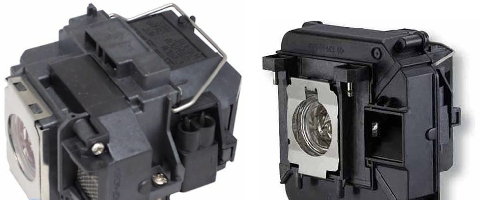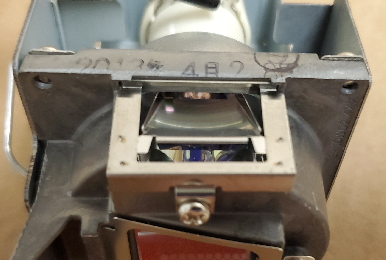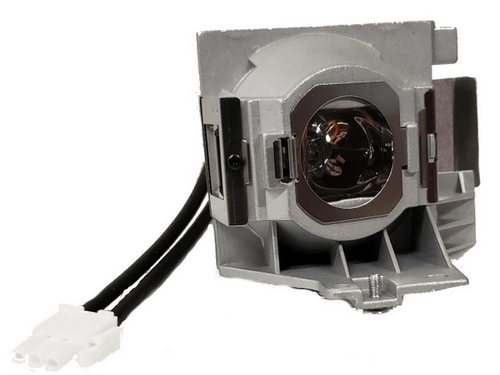Projector lamps are not as mysterious as they seem. They are definitely high technology but once you learn about the specifics, they are more science than magic.
The end goal is to educate you, the potential customer.
Then you can make the best choice when replacing your projector lamp. Obviously, I hope you buy it from us, but if not, I want you to be confident in your choice if you don’t.
Projector lamps fail for all sorts of reason. Projector lamps are designed to run a certain amount of time. That design relies on certain constants, such as cooling and run time. The cooler a lamp runs, the longer it will run properly. The hotter it runs, the shorter it’s run time will be. By nature of design they generate a lot of heat. The manufacturer of your projector has a built-in method to handle that heat. Therefore there are so many fans, and in some cases, air filters. They manage the heat by drawing in cool ambient air and blowing out the hot air generated by the lamp and other electronics.
If your projector has been sitting in the same place for a while, it will get dust inside and that will affect the cooling functions. Most of the time this affect is minimal, but if you notice your lamps failing early (especially if they burst when they fail) you may have a deeper build-up of dust causing the temperature to run higher than it should. Projectors will sense if they get too hot and will warn you, but they will not notice if they are running hotter than they should if it’s not as hot as the overheating threshold. This is the main cause of short lamp life, but not the main cause of lamp failure.
The main cause of lamp failure is old age of the lamp. Once the lamp has been used for its designed life span, the image will be dim, colors not as vibrant. The lamp may take longer to come on. Instead of seeing the picture 10-15 seconds after power-on, it may take up to one minute or more. Most projectors will have an on-screen warning. They will display “Lamp Time Expired” or “Replace Your Projector Lamp”. There are many different messages. Your manual will have the warning specific to your projector. The other symptom is no light at all. You press power, the fans turn on, and you hear the projector try to start but after 3 tries you see the Lamp LED turn on or flash (model dependent).
Many people will continue to run the lamp after the message appears, but I strongly advise you to replace the lamp as soon as you see the message or warning. Continuing to run the lamp puts your projector at risk for serious damage. If your lamp runs too far past its rated hours, the quarts glass can get soft and cause part of the lamp to explode inside. This throws molten glass all over the inside and can truly ruin your projector at the worst. At the best you will need to pay for a professional cleaning to remove the glass to keep it from jamming a fan or breaking a color wheel. This isn’t the point of this article, but I wanted to address it.
The short of it is, replace your lamp when you get the warning. Spend the money now rather than waiting and having to potentially spend 3x the amount on repair and a lamp once it explodes.
Now to the replacement options. There are so many options. So many that it is confusing, and many sellers take advantage of this. I am going to focus on the tactics and methods used to take advantage of consumers so that you are not taken advantage of.
Let us go over the types of replacement lamps.
- OEM from the manufacturer. This is the most expensive option. It will arrive in a box that has the logo of your projector manufacturer usually. Some companies have merged and been bought lately so it might say Panasonic if you own a Sanyo, but no matter what, the box will have an original manufacturer name. These are not always the best option though. Unless you are still under the original warranty there is no real need to buy an OEM. Most OEM lamps are not actually made by the company they are sold for. Many are made by companies who also make them for the aftermarket. This brings us to the next type.
- Aftermarket with Original Bulb Inside. This is what we sell. We only offer lamps that are built with a proper manufacturer bulb. We use lamps that utilize Philips, Ushio, Phoenix, Matsushita, and Osram replacement bulbs inside. There are no compatible bulbs or recycled bulbs. These are brand new bulbs, that are built into brand new housings. The housings we sell (with the original bulb) are made for the aftermarket. This means that there are no corners cut and the lamp housing and its parts are brand new. This is important. All the lenses, the bulb brackets and connectors are all brand new and tested to fit and perform as the original. You can save as much as 80% on the cost over the OEM. Our manufacturer has been in business almost as long as we have. We work closely with them to ensure the lamps we sell are top notch options. Many customers use us exclusively because we only focus on lamps. We do not bother with other items so that we can be sure that the lamps we sell are the best option.
- Aftermarket with Compatible Bulb Inside. Not a great option for 95% of the customers. There are many old projectors that no longer have OEM or Original Bulb Inside options. Old Rear Projection TVs that use lamps may also be a candidate for compatible lamps. These use bulbs made overseas on old factory equipment. They are non-branded and usually built to unknown specifications. The life span can be hours or days. The light output may vary even across the same models. These are normally seen on Amazon or on more unscrupulous websites that advertise them as OEM equivalents. I always look at the price. If you see a lamp for $20-40, then you can be pretty sure it’s a compatible regardless of the title of the listing. They use terms like “Genuine” or, ” Original Quality”. They even try and make it look real by assigning a “brand”. Just because it has a real name, doesn’t make it a good lamp. The only time (in my opinion) to buy a compatible lamp is when you have no other options or you don’t really care how the lamp runs. Maybe you have a 15 year old projector and want to run it outside for a weekend party? Compatible lamp might be an option. That said, it still may fail before the party is over. I never would buy a compatible personally, but your mileage (and needs) may vary.
The important thing to know is that the cost of a projector lamp is directly in line with the quality of the projector lamp. That price is determined by the manufacturer and how much they spent on the parts. This is why some lamps are $30 and the same part number might be $130 elsewhere. This is not greed. This is purely the level of quality.
Here are a few things to look for when purchasing a replacement projector lamp. These items will directly affect your picture quality, projector longevity and the amount you will end up spending to keep your projector running.
- Bulb/Lamp type.

The bulb or lamp is the actual working portion of your projector lamp. This is the glass and ceramic item that emits the light. You can see it by following the wires from the connector to where they are affixed (usually with a pair of screws). If the projector lamp you are at is using a bulb from a major manufacture, it will say Philips/UHP, Osram/PVIP, Ushio/NSHA, Phoenix/SHP, Matsushita/HS or Iwasaki/UHE. If there is no name listed, you can be reasonably sure it is a knock-off and not worth your time or money - Housing construction.

Look for housings that have good quality moldings. Many aftermarket housings are made in the same factory as the OEM. Therefor the projector lamp housing should have the same general shade of black instead of a grey or lighter look. This ensures the special high temperature plastic is formulated right to ensure long operation without any warping of the housings. This makes your lamp run longer and keeps the light pointing where it should. - Housing vent alignment.

Inside many projector lamp housings there is a set of metal vents that point the projector’s cooling air where is needs to be. This cools the inside of the bulb, where most of the heat is generated. If your old lamp had a failure where the wire burned off the end (like in this picture), it indicates a lack of cooling air or a miss-aligned or just missing vent assembly. This will shorten the life of the lamp drastically. Many compatible lamps do not use the vents correct or at all. This makes them cost less but makes them fail very quickly. - Connector wires.

You would think wire is wire. Wire is not just wire in a projector lamp. Wires in projector lamps are designed to handle the heat and high-power electricity that makes projector lamps work. Most projector lamps use a 20,000 volt insulated wire made from silicone. This wire is rated to at least 300f(150c) and 10-20KV. During initial projector lamp ignition, this voltage can be up to and over 10,000V. During normal use, the power can be as high as 3-4 amps at 100-120v. To a normal person, this is a lot of power for a wire. Many compatible lamps use normal wire that is only rated to 300v and 150f(70c). This can lead to melted wires and short circuits in projectors. A bad time either way unless you have the right wire, which costs more than the cheap wire. Again, you get what you pay for. - IR Block Lens.

This only applies to DLP projector lamps, but it is a critical and commonly ignored issue. This is the piece of glass that sits in the front of the projector lamp housing. It should have a coating that is obviously red/blue/purple when you look at it from a slight angle. this coating is what blocks the infrared light radiation from getting past the color wheel and causing its sensor to fail, or letting the infrared radiation get inside the optical assembly causing the internals to overheat and ruin things like the DLP chip or the lenses that are expensive and difficult to replace. An incorrectly coated IR block lens can truly ruin your projector.
As I said above, the red/blue/purplish coating is what you want. If you see no coating or a ‘greenish’ coating, that lamp is a lamp that will ruin your projector. The proper coating has to be applied with special plasma sputtering equipment which is not cheap. The extra cost this adds to the lamp is worth it when you look at repair costs for things that the infrared light radiation can damage.
These are the main items to look for when you buy a replacement projector lamp. Hopefully you buy it from us, but if not, this will tell you what you need to know to make an informed choice.
Every lamp on Amazon is not the same. Every lamp you find on Google is not the same. Knowing what makes them different is the best tool you, as the consumer can have to make the decision that works best for you.
If you have any questions about our projector lamps, please get in touch with our very well-trained staff. They can assist you in finding the high-quality lamp you need and will have it shipped as quickly as you need. They can also answer any questions you have after you receive your lamp whether it be an install or troubleshooting question.
They can be reached Monday through Friday, 9am to 5pm Eastern Standard time at 1-800-664-6671, Sales@Purelandsupply.com or via our Online chat.
As always, Thank You from all of us at PurelandSupply.com!

